Want to just get started? Click here to sign up for Semrush and find competitor backlinks today.
Why is my competition outranking me?
This is a common question that we hear all of the time when we’re consulting with brands and website owners. They spend so much time producing content and prioritizing their on-page SEO, yet they’re still being outranked by direct competitors. How is this possible?
Google’s algorithm factors in more than just your on-page SEO efforts. Backlinks also play a major role in your ranking position.
Some of you know this already, so you’ve been working hard on your link building strategy. But it just hasn’t been enough to push your ranking to a top spot.
If this scenario sounds familiar, it’s time to reverse engineer your competition’s backlinks.
Going through this process will help you figure out why other websites are ranking higher than yours. There’s a good chance it comes down to their link profile.
Once you’re able to see where their backlinks are coming from, you can take steps to land backlinks on those same websites and potentially steal those links away from your competitors.
We know that terms like “reverse engineering” and “backlinks” can seem complex or intimidating to those of you who haven’t done this before. But it’s really not that complicated.
Top SEO Tools Pros Really Use to Reverse Engineer Your Competitor’s Backlinks
If you want to reverse engineer your competitor’s backlinks, you’ll need SEO tools. Here’s the best options.
- Semrush – Best Overall SEO Software
- Ahrefs – Best Advanced SEO Software
- Yoast – Best SEO Plugin for WordPress
- Screaming Frog – Best SEO Crawling Software
- Pitchbox – Best Outreach Software
You can read our full reviews of each SEO tool here.
4 Steps to Find Competitor Backlinks
Simply follow the steps that we’ve outlined in this guide and you’ll be on your way to a higher ranking position.
- Conduct keyword research
- Identify your competitors
- Analyze competitor link profiles
- Build your own backlinks
Step 1 – Conduct keyword research
Before you do anything else, you need to take the time to identify the keywords that you’re fighting for. To really gain a competitive edge, you’ll need to create a long list of words and phrases.
We don’t want to spend too much time here explaining how to find the right keywords.
You can refer to our complete guide on keyword research for a more in-depth analysis of this process.
However, we will say this; prioritize long-tail keywords.
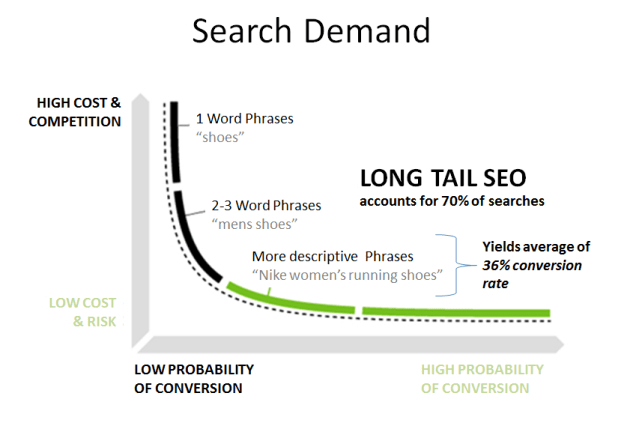
Long-tail keywords are responsible for almost 92% of all internet searches. These keywords also have higher conversion rates.
For example, it’s better for you to focus on keywords like “small business content marketing” as opposed to just “marketing.”
The reason why you need to do keyword research first is because you’re going to use these search terms to identify your competitors in the next step. Competing for a singular word like “marketing” is a battle you don’t want to fight.
There are so many tools, resources, and guides for keyword research. But here’s a quick tip that you can easily use.
Type your long-tail keyword into Google, and just scroll to the bottom to see related searches.

You can leverage these related searches to your advantage as we continue as well. It’s a shortcut that we take all of the time.
Step 2 – Identify your competitors
Now that your keyword research is complete, you have to determine who exactly you’re competing with. The answers may surprise you.
All too often we consult with businesses who tell us who their competitors are when we first start working together. But once we start doing our own research, we discover that they’re actually competing with completely different companies.
Let’s say you have a brick and mortar bicycle shop in a small town. If there’s another bike shop across the street, it’s fairly obvious that they are your competition. However, when you’re conducting business online, it’s not always so straightforward.
So head over to Google and start searching for the long-tail keywords that we previously identified.
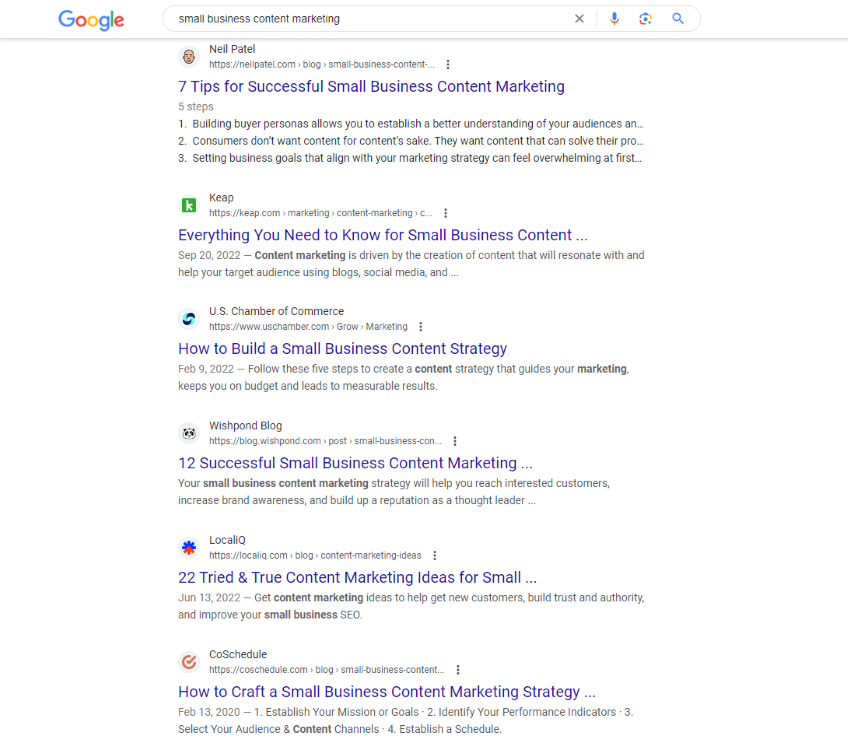
For this example, we stuck with “small business content marketing” as our keyword. Skip over the advertisements and eliminate websites like Wikipedia.
If you’re selling physical products, we’d also skip over big brands like Walmart or Amazon. Are you competing with them? Sure, but you’re not going to be able to use their backlinks to outrank them. It’s just not realistic.
Scroll through the remaining results. We’d recommend creating a spreadsheet where you can simply list the URLs for your competitors. This is the best way to stay organized.
Go through the top 10-20 results. Then continue this process for all of the keywords and related search terms.
After that, eliminate any duplicates from your spreadsheet, but put a star next to sites that ranked for multiple keywords. Those brands will definitely be a priority when it comes time to analyze their link profiles.
This is a highly effective process, but it does take some manual work on your end. For those of you who would rather use technology to your advantage, you can use software like SimilarWeb to help you out.
They have a wide range of tools that can be used for analyzing your competition. Competitor identification is one of those features.
Step 3 – Analyze competitor link profiles
So you have a list of your top competitors based on the search results from your keyword research. You need to take those websites and analyze their link profiles.
You’re going to need to use software to help you do this. There are plenty of tools available online, but one of our favorites is Semrush.
We like this software because it’s extremely versatile. With that said, you’ll need to pay to use their tools. If you get billed on an annual basis, plans start at $108.33 per month.
Start by using the “Backlink Gap” tool.

From your dashboard menu on the left side of the screen, look for the “Gap Analysis” option. The Backlink Gap tool can be found here.
Now you’re going to want to put in the domain names of your competitors. We highlighted that in the screenshot above across the top of the screen.
All we did was put in the five websites that we saw in the Google search results from earlier.
One of the main benefits of this tool is that you can see what backlinks your competitors have in common.
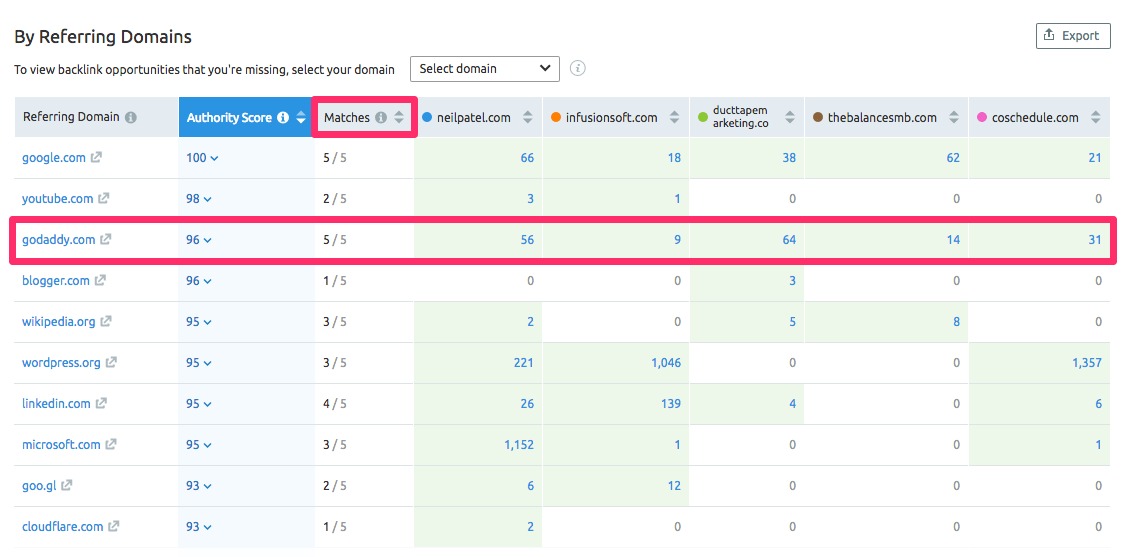
You can organize and filter the results however you want. In this example, we have the chart organized by the authority score of the referring domains.
When it comes to building a strong link profile, it’s extremely important that you prioritize websites with high authority scores.
The chart shows us that all five of these competitors have backlinks on from GoDaddy.com. Since GoDaddy has a high authority score, this would definitely be a website that we’d add to my list.
There are tons of other ways for you to organize and analyze this data. You can breakdown the results over the last three months, past year, or all time to get a better idea. Sort each column individually to see the sites providing the most backlinks to each competitor as well.
Using the Gap Analysis tool from SEMrush is just scratching the surface in terms of what they offer. You can analyze the link profiles of each competitor individually.
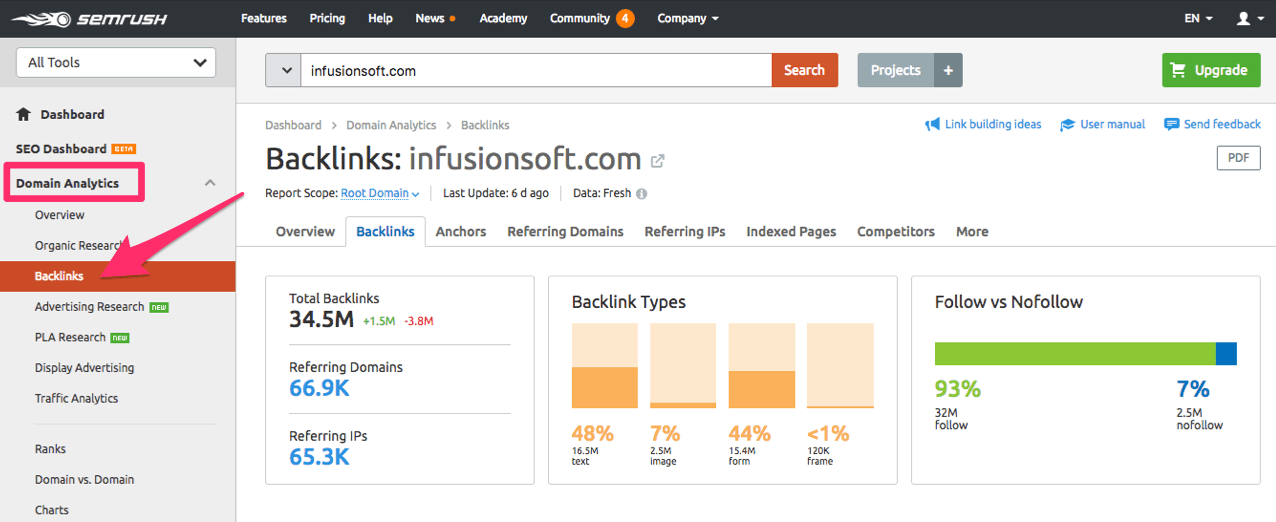
Refer back to the dashboard menu on the left side of your screen. Click on “Domain Analysis” and then navigate to the “Backlinks” option for the full report.
For this example, we used infusionsoft.com, which was one of the sites on our list from the Google results.
This is an overall snapshot of their link profile. You can see things like their total backlinks, referring domains, referring IPs, types of backlinks, and the percentage of follow links compared to nofollow links.
If you continue to scroll through the report, you’ll see an even deeper analysis of backlinks.
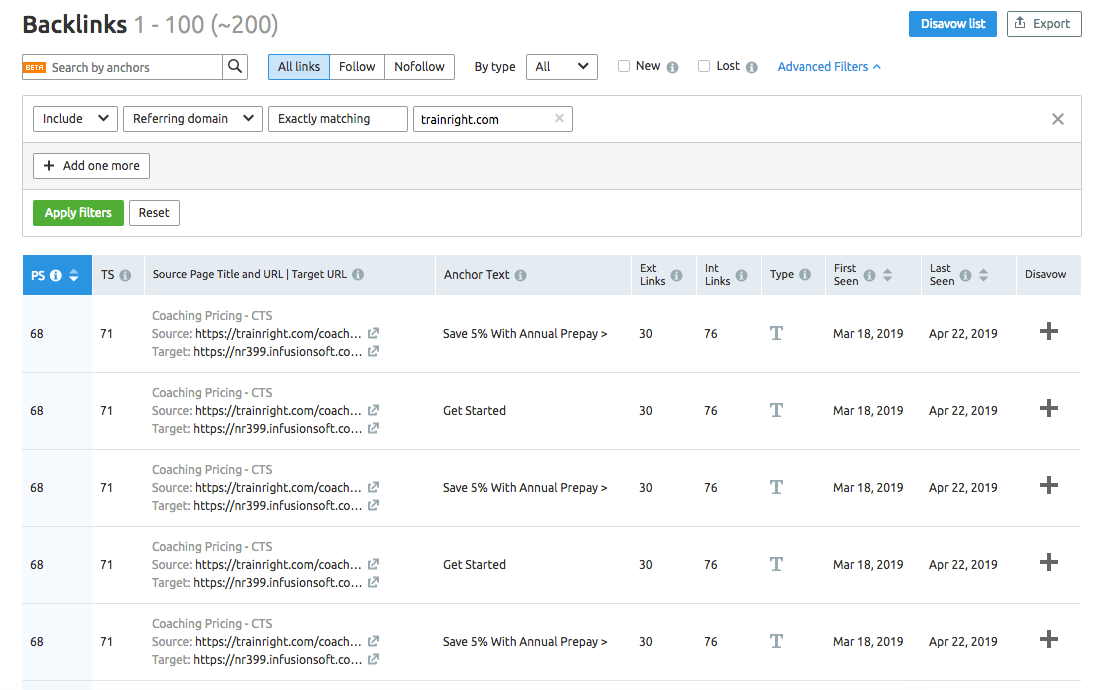
This report shows you each individual backlink.
There is so much valuable information for you here. Sort by page score, trust score, and how recent the backlink was displayed on the referring domain. It even tells you the anchor text being used for the backlink.
If you click on the arrows next to the source page URL, it will bring you directly to the page where that backlink is displayed.
Take full advantage of all of the advanced filters to help you out. You’ll be able to use this to determine if these referring domains are worth pursuing for your own backlinks.
In addition to Semrush, you can also use tools like Ahrefs and Majestic for analyzing competitor link profiles.
Step 4 – Build your own backlinks
After you’ve analyzed the link profiles of your competitors, you should have a list of prospective websites that you want to build backlinks on.
Now all you have to do is figure out how to get your links on those sites.
Again, this is another reason why you should be keeping notes on a spreadsheet. Not every link and referring domain will be the same. So you could have notes that look something like this:
- Website A — Resource page
- Website B — Blogs
- Website C — Infographic
- Website D — Case study
You’ll also want to find the proper contacts at each website. Then you can just send them an email with your pitch.
For something like building links from resource pages, it will be a pretty straightforward process.
This can be a little bit more complex if you want to steal your competitor’s backlinks. Here’s an example to show you whatwe mean.
Let’s say that during your link profile analysis, you learned that one of your competitors has dozens of backlinks on one particular website. All of those links were used for something similar, like a reference to a statistic in a blog post.
But you learned that the study was from a few years ago. You can reach out to that website and send an email saying something along these lines:
Hey! I just read your blog post called “XYZ” and loved it. I thought it was extremely informative. But I noticed that some of your statistics are outdated. I actually conducted a recent study with updated results. [link to your page]
I think this will add more value to your blog, so feel free to use it as a resource. My only request is that you please link to my site as the source.
As you can see from the word choice and tone of this message, it doesn’t involve calling out the competitors by name or asking for the link to be removed. That’s just implied.
Your messages will vary based on the type of content that you’re pitching. It’s also possible to get featured on these websites without stealing your competitor’s links. But with that said, it’s always an added bonus if you can get a link added while they’re simultaneously getting one removed.
Conclusion
If you’re struggling to outrank your competitors, you can use reverse engineering to build backlinks that they’ve had success with.
Before you can do that, you’ll need to do some keyword research to make it easier to identify your competition.
Next, you can leverage software to analyze the link profiles of your competitors.
Just take that research and use it to build backlinks on those same websites. If you play your cards right, you can even get your competitor’s links replaced with one of your own.
We highly recommend adding this process to your link building strategy.

